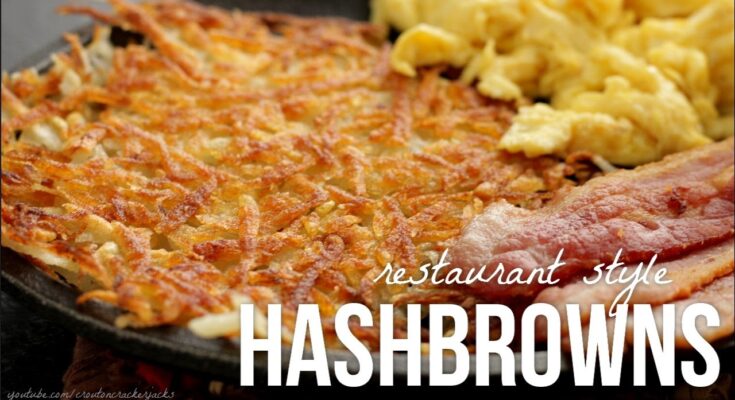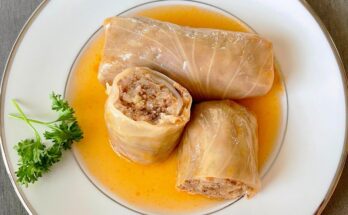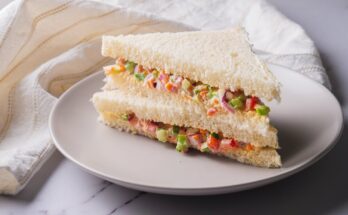Hash Brown Recipe: Hash browns are a beloved breakfast staple known for their crispy exterior and soft, flavorful interior. They originated in the United States but have become a favorite worldwide. Whether served solo or as a side dish, hash browns add a golden, crunchy delight to your plate.
The simplicity of hash browns makes them versatile. They’re made primarily from potatoes, but you can customize them with spices, herbs, or cheese for added flavor.
Ready to learn how to create this breakfast classic? Let’s dive in!
Ingredients for Perfect Hash Browns
Here’s what you’ll need to get started:
Basic Ingredients:
- 3 medium-sized potatoes (Russet is ideal).
- 1 medium onion (optional, for added flavor).
- 2 tablespoons of all-purpose flour (or gluten-free flour).
- 1 egg (for binding, optional for vegan versions).
- Salt and pepper to taste.
- Cooking oil or butter (for frying).
Optional Add-ons:
- Garlic powder for a hint of spice.
- Chopped parsley or chives for a fresh touch.
- Shredded cheese for cheesy hash browns.
These ingredients are flexible, so feel free to tweak them according to your taste preferences.
Essential Kitchen Tools
To make hash browns seamlessly, gather the following tools:
- Grater: For shredding the potatoes.
- Mixing Bowl: To combine ingredients.
- Colander or Clean Towel: To drain excess water from potatoes.
- Frying Pan or Skillet: For cooking.
- Spatula: To flip and serve.
Pro Tip: If you don’t have a grater, you can use a food processor with a shredding attachment to save time.
Preparing the Potatoes
The secret to the perfect hash brown lies in the potato preparation:
- Selecting Potatoes: Russet potatoes work best due to their high starch content, which helps create crispy edges.
- Washing and Peeling: Rinse the potatoes thoroughly under cold water. Peel them for a smoother texture or leave the skin on for a rustic touch.
- Grating the Potatoes: Use a box grater to shred the potatoes into thin strips.
- Draining Excess Moisture: This is crucial! Place the grated potatoes in a colander or wrap them in a clean towel. Squeeze out as much water as possible to ensure crispy hash browns.
Seasoning and Flavoring
Seasoning makes all the difference in hash browns. After draining the potatoes, transfer them to a bowl and add salt, pepper, and any optional seasonings like garlic powder or paprika. Mix thoroughly to evenly coat the potatoes.
Tip: Be mindful of the salt quantity, as it can draw out more moisture. A light sprinkle goes a long way.
Cooking Techniques
There are two main methods for cooking hash browns:
1. Pan-Frying: This is the traditional method. Heat oil or butter in a skillet, spread the potato mixture evenly, and cook until golden brown on both sides.
- Advantages: Quick and delivers a crisp texture.
- Disadvantage: Requires close attention to avoid burning.
2. Baking: For a healthier option, spread the seasoned potato mixture on a baking tray lined with parchment paper. Bake at 400°F (200°C) for 25-30 minutes, flipping halfway through.
- Advantages: Less oil is needed.
- Disadvantage: Takes longer to cook.
Both methods have their charm, so pick one that suits your preference.
Step-by-Step Guide to Making Hash Browns
- Prepare the Potatoes: Wash, peel, grate, and squeeze out excess water.
- Mix Ingredients: Combine the grated potatoes with salt, pepper, flour, and egg in a bowl. If using add-ons like cheese or herbs, mix them in now.
- Heat the Pan: Preheat a skillet over medium heat with a generous layer of oil or butter.
- Shape the Hash Browns: Scoop small portions of the potato mixture and shape them into patties.
- Cook: Place the patties in the hot skillet. Cook each side for 4-5 minutes until golden and crispy.
- Drain and Serve: Remove from the pan and place on paper towels to absorb excess oil. Serve hot.
Common Mistakes to Avoid
- Skipping the draining step: This leads to soggy hash browns.
- Overcrowding the pan: Cook in small batches for consistent results.
- Using the wrong oil temperature: Too hot, and they’ll burn; too cool, and they’ll be greasy.
Serving Suggestions
Hash browns are versatile! Pair them with eggs, toast, or even avocado slices for a hearty breakfast. For a fun twist, use them as a base for toppings like sour cream, salsa, or guacamole.
Variations of Hash Browns
Hash browns are a blank canvas for culinary creativity. Here are a few variations you can try to elevate this classic dish:
- Classic Hash Browns: Stick to the basic recipe for a traditional, crispy delight. Serve with ketchup or hot sauce for a quick snack.
- Cheese and Herb Hash Browns: Add shredded cheddar cheese and a mix of fresh herbs like parsley or chives to the potato mixture for a cheesy, flavorful twist.
- Vegan Hash Browns: Skip the egg and use a tablespoon of cornstarch or ground flaxseed mixed with water as a binding agent. They’re just as delicious and crispy.
- Gluten-Free Hash Browns: Replace all-purpose flour with almond flour or a gluten-free blend to make them gluten-free.
- Spicy Hash Browns: Mix in finely chopped jalapeños, chili flakes, or a dash of cayenne pepper for a spicy kick.
These variations allow you to cater to dietary preferences or simply switch things up for your next meal.
Storage and Reheating Tips
Hash browns can be stored and reheated without losing their signature crispiness. Here’s how:
- Storing Leftovers: Place cooled hash browns in an airtight container and store them in the refrigerator for up to 3 days.
- Freezing: For longer storage, flash-freeze cooked hash browns on a tray, then transfer them to a freezer-safe bag. They can be frozen for up to 3 months.
- Reheating:
- Oven: Preheat to 375°F (190°C) and bake for 10 minutes until hot and crispy.
- Skillet: Reheat in a lightly oiled pan over medium heat, flipping occasionally.
- Air Fryer: Heat at 350°F (175°C) for 5-7 minutes for a quick crisp.
Pro Tip: Avoid microwaving hash browns, as they can turn soggy.
Healthier Alternatives
If you’re watching your calorie intake or looking for a more nutritious version, consider these healthier alternatives:
- Low-Oil Cooking: Use a non-stick skillet and a light spray of oil instead of deep frying. An air fryer is another great option for achieving a crispy texture without excess oil.
- Sweet Potato Hash Browns: Substitute regular potatoes with sweet potatoes for a sweeter and more nutrient-rich option.
- Add Veggies: Mix grated zucchini, carrots, or spinach into the potato mixture for added fiber and vitamins.
- Whole-Grain Flour: Replace all-purpose flour with whole-grain or almond flour to boost the nutritional value.
These tweaks make hash browns a guilt-free indulgence.
Cultural Variations
Hash browns have inspired similar dishes around the world. Let’s take a look:
- Rösti (Switzerland): This Swiss version uses grated potatoes shaped into a large, flat cake, often served as a side dish.
- Latkes (Jewish Cuisine): Made with grated potatoes, eggs, and matzo meal, these are fried to perfection and often enjoyed during Hanukkah.
- Boxty (Ireland): A mix of mashed and grated potatoes, this Irish pancake-like dish is a hearty breakfast favorite.
- Potato Galette (France): Thinly sliced potatoes layered and cooked to form a crispy, golden round.
Each variation showcases unique flavors and techniques, proving that potatoes are truly universal.
FAQs about Hash Brown Recipe
What are the best potatoes for making hash browns?
For the crispiest hash browns, choose starchy potatoes like Russets or Idaho. These potatoes have a high starch content that helps create a crispy exterior when fried.
How do I prevent my hash browns from being soggy?
To avoid soggy hash browns, thoroughly rinse the grated potatoes to remove excess starch. After rinsing, make sure to dry them completely with a clean towel or a salad spinner. Less moisture means crisper hash browns.
Can I make hash browns without oil?
Yes, you can make hash browns in a non-stick skillet without oil, but adding a little oil helps achieve a golden and crispy texture. For a healthier alternative, use a light spray of olive oil.
Are hash browns gluten-free?
Hash browns are naturally gluten-free as they are made from potatoes. However, ensure that they are not contaminated with gluten from other cooking surfaces or utensils if you need them to be strictly gluten-free.
Can hash browns be frozen for later use?
Absolutely! To freeze hash browns, cook them until they are slightly underdone, let them cool, and then freeze them flat on a baking sheet. Once frozen, transfer them to a freezer-safe bag for long-term storage.
Conclusion
Making hash browns is a rewarding experience that lets you enjoy a timeless comfort food at its finest. Whether you prefer them crispy and traditional or loaded with cheese and spices, this guide equips you with all the tips and tricks for success. Experiment with different flavors, cooking methods, and variations to find your perfect hash brown recipe.
Grab your potatoes and get cooking—you won’t regret it!



